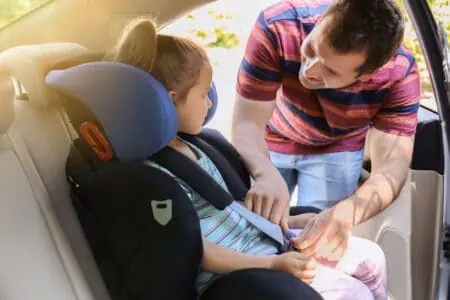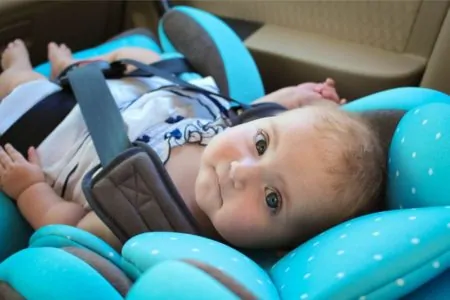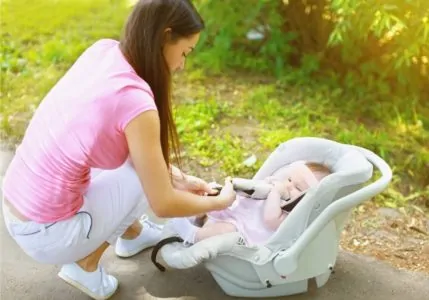Keeping your child safe on the road is your top priority. Yet, navigating the maze of car seat safety can feel overwhelming. With changing laws, complex manuals, and alarming statistics, it is hard to know if you are doing it right.
This guide breaks down the essential car seat stats and facts you need to know. We cover everything from the latest crash data and legal requirements to installation hacks and the newest safety tech.
Whether you have a newborn in a bucket seat or a big kid ready for a booster, this resource will help you hit the road with confidence. Let’s dive into the insights that make every trip a safer one.
Key Takeaways
- Car seats save lives: Restraints reduce the risk of fatal injury by 71 percent for infants and 54 percent for toddlers.
- Misuse is common: nearly half (46 percent) of all car seats are installed or used incorrectly, reducing their effectiveness.
- Rear-facing is safest: Experts recommend keeping children rear-facing as long as possible, often past age four, to protect the head and spine.
- Laws are minimums: State laws often lag behind best safety practices; always follow the manufacturer’s height and weight limits over state minimums.
35 Car Seat Statistics and Facts
We have organized 35 vital facts into five categories. By the end, you will have the knowledge needed to maximize your child’s safety on every drive.
Car Seat Safety and Fatality Statistics
Using a car seat correctly is the single most effective way to protect your child in a crash. Here are the hard numbers on safety statistics and why it is vital to install and use the seat properly.
- Crashes are a leading cause of death: For children between ages one and 13, car crashes remain a leading cause of death (1). A properly used seat significantly lowers this risk.
- Restraints work: In 2017 alone, car seats saved an estimated 325 lives of children aged four and younger (2). Conversely, 40 percent of children killed in accidents in 2021 were unrestrained (3).
- Widespread misuse: A startling 46 percent of car and booster seats are not used as intended (4). This includes loose installation or incorrect harness positioning.
- The 4 steps of safety: Proper use involves four phases: Select the right seat (rear-facing, forward-facing, booster, seat belt); install it tightly; register the product for recalls; and buckle the child correctly every time.
- Age vs. Size: While the CDC recommends rear-facing until at least age two to four (5), best practice is to max out the seat’s weight or height limits before switching modes. Do not rush the transition.
- Recent fatality data: In 2021, over 700 children aged 12 and younger died in US car crashes (6). Over one-third of them were not buckled up at all.
- Risk increases with age: Restraint use drops as children get older. Studies show less than one percent of infants are unrestrained, compared to 13 percent of children aged eight to 12.
Usage and Installation Statistics
Even the most expensive seat fails if installed incorrectly. Here are the risks associated with improper use.
- Front seat danger: Children under 13 should always ride in the back. Airbags deploy with massive force and can kill young children, especially those in rear-facing seats.
- Misuse rates are high: While national averages hover around 46 percent, some local checks find misuse rates as high as 85 percent (7).
- Common installation errors: Frequent mistakes include incorrect recline angles (causing head slump), loose harness straps (the “pinch test”), and using the wrong belt path.
- Ejection risks: Improper installation can lead to seat ejection (8). If the seat moves more than one inch side-to-side, it is not tight enough.
- Spinal injury potential: Loose harnesses allow the body to slam against the shell or other interior parts during a crash, significantly increasing the risk of spinal and neck trauma.
- Hardware failure: Defective or expired seats may have degraded plastic or faulty buckles. Always buy new or from a trusted source to ensure the structural integrity is intact.
- The “Winter Coat” danger: Puffy jackets compress instantly in a crash (9). This leaves slack in the harness, allowing the child to slip out. Use thin layers and place a blanket over the buckled harness instead.
Facts About Types of Car Seats
Understanding the different stages of car seats ensures your child is always in the most protective gear for their size.
- Rear-facing options: You can choose an infant bucket seat (portable) or a convertible seat (stays in the car). The infant seat is generally safer for newborns due to better fit (10), but convertible seats allow rear-facing for much longer.
- Anti-rebound technology: Modern rear-facing seats often feature anti-rebound bars or load legs. These devices absorb crash energy and limit the seat’s rotation, protecting the child’s head.
- Extended rear-facing: While some laws allow forward-facing at age one, physics favors rear-facing (11). It supports the heavy head and weak neck, distributing crash forces across the entire back. Aim for age four or until the seat’s limits are reached.
- The top tether: When facing forward, the top tether is non-negotiable. It secures the top of the seat to the vehicle anchor, reducing forward head movement by up to six inches during a crash.
- Forward-facing limits: Most convertible seats allow forward-facing harnesses up to 65 pounds. Keep your child in a 5-point harness until they max out this weight or height limit before moving to a booster.
- Booster basics: Boosters position the adult seat belt correctly over strong bones. Children should stay in a booster until they are 4’9″ tall, usually between ages 8 and 12.
- The 5-Step Test: A child is ready for a seat belt only when: their back touches the seat; knees bend at the edge; the belt lies on the thighs (not belly); the shoulder belt crosses the chest (not neck); and they can sit still for the whole ride.
Pro Tip The Pinch Test
Car Seat Laws By State
Laws vary wildly across the US. Remember: the law is the minimum requirement, not the gold standard for safety.
- California: Kids under two must ride rear-facing unless they weigh 40+ pounds or are 40+ inches tall (12). Children under eight must be in a car seat or booster in the back seat.
- Florida: Children five and under must be in a crash-tested device. Sadly, children aged four and five can legally use a seat belt in some cases, though this is highly unsafe and not recommended by experts.
- Hawaii: Rear-facing is required until age two. Children must use a harnessed seat or booster until age ten, unless they are taller than 4’9″.
- Kentucky: Children under 40 inches (or under seven years old) need a safety seat. Boosters are required until age eight or a height of 57 inches.
- Minnesota: A new law requires rear-facing until age two. Children must be in a booster until age nine or until they pass the 5-step seat belt fit test.
- New Jersey: One of the strictest states. Rear-facing until age two and 30 pounds. Harnesses required until age four and 40 pounds. Boosters required until age eight or 57 inches.
- Texas: Children must use a safety seat system until age eight or until they are taller than 4’9″ (57 inches).
Warning
Innovation and Design Features
Manufacturers constantly engineer new ways to improve crash protection and ease of use. Here are seven innovations making travel safer.
- Rotating car seats: Seats like the Maxi-Cosi 360 Pro Family rotate 360 degrees and slide out toward the parent (14). This saves your back and ensures you can tighten the harness correctly every time.
- Lie-flat technology: Models such as the Pebble 360 Pro offer full lie-flat positions. This prevents head slump in newborns and keeps their airways open, making longer trips safer.
- Rigid LATCH/ISOFIX: Modern seats often use rigid connectors that click directly into the car’s anchors. This reduces installation errors significantly compared to flexible belt-style latches.
- SensorSafe technology: Some brands now integrate chest clips that sync to your phone. They alert you if the chest clip unbuckles, the car gets too hot, or if the child is left unattended.
- Load Legs: A feature borrowed from Europe, the “load leg” extends from the seat base to the car floor. It prevents the seat from rotating forward in a crash, protecting the head and neck.
- FMVSS 213 updates: Federal standards are evolving (15). New side-impact testing protocols are pushing manufacturers to add more foam and structural reinforcement.
- Aircraft certification: FAA-approved seats ensure safety in the skies. Using a car seat on a plane protects against turbulence and ensures you have a safe seat at your destination.
Important Safety Tips and Guidelines
You want the best outcome if the unthinkable happens. Here are 11 rapid-fire safety tips to keep your setup secure.
- Master the install: Read the manual twice. Watch the manufacturer’s official video. Then, schedule a check with a certified Child Passenger Safety Technician (CPST).
- Limit projectiles: In a crash, loose objects become missiles. Avoid aftermarket accessories like hard toys or suction-cup mirrors unless they are crash-tested with the seat.
- Check the history: Never buy a used seat unless you know its full history. You need to be 100 percent sure it has never been in a crash, is not expired, and has no missing parts.
- Airbag awareness: Never place a rear-facing seat in front of an active airbag. If you must use the front seat (in a truck, for example), turn the airbag off manually.
- Register immediately: Mail in the registration card or register online. This is the only way the manufacturer can contact you regarding safety recalls.
- Delay the switch: Don’t rush to the next stage. Keep your child rear-facing until they max out the seat’s limits, then forward-facing harnessed until they max that out too.
- Size upgrades: Monitor your child’s height. Most seats are outgrown when the head is one inch below the top of the shell, not just when the weight limit is reached.
- Booster positioning: Use a high-back booster for better side-impact protection and to keep the child in position if they fall asleep.
- Anchor the top: We said it before, but it bears repeating: use the top tether for every forward-facing install. It is the most ignored safety step in the US.
- Strip the layers: Remove puffy coats. Ideally, the harness sits close to the body. You can put the coat on the child backward over the harness for warmth.
- Shoulder strap height: For rear-facing, straps must be at or below the shoulders. For forward-facing, straps must be at or above the shoulders.
FAQs
In Conclusion
The statistics are clear: proper car seat usage is the difference maker. While the numbers and laws can be confusing, the goal is simple. Keep them restrained correctly, keep them rear-facing longer, and always double-check your install.Safe travels!








